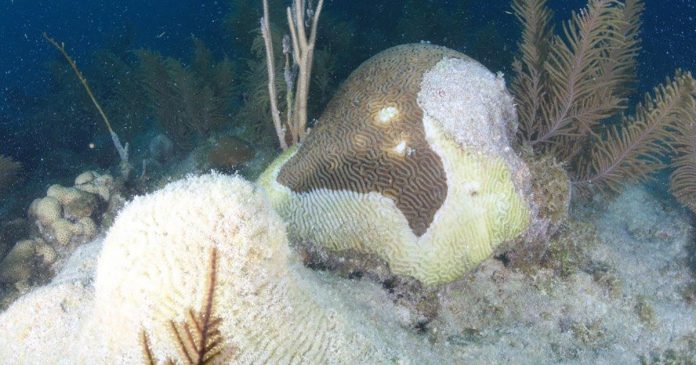The Department of Nature and Environment (DNM) wishes to share important information regarding a phenomenon taking place in the marine life in certain dive sites in the Caribbean islands, and particularly there is worry in Bonaire about the presence of this coral disease.
The name of the disease affecting the corals is Stony Coral Tissue Loss Disease (SCTLD). The department is worried because the disease is very aggressive and can be deadly for the colony of corals, and thus affects the quality of our marine life in the region.
In this article, DNM wishes to explain what this disease does to corals, how it manifested in Bonaire, how it is transmitted, and what we can do to prevent it here in Aruba in order to help mitigate the problem.
What does SCTLD do?
Stony Coral Tissue Loss Disease destroys the soft tissue that covers coral, and can affect 30 types of coral that exist in the marine life which are the ones forming and growing our reefs. When the disease attacks the coral, the result can be fatal because it can kill an entire colony of coral in only a few weeks or months after infection.
It can affect the coral severely. SCTLD is considered the most dangerous and deadly among coral diseases, and it manifests rather quickly. It must not be confused with coral bleaching, these are two different phenomenon.
DNM noted that almost a year ago Bonaire published information regarding the disease and its spread in the Caribbean and Florida. Back then, STINAPA (non-governmental organization responsible for the management of the national parks on Bonaire) mentioned during a webinar that they still hadn’t found any corals with the disease in their waters, but in Aruba there is a case of suspected infection. Aruba itself did not receive a notification of this alert.
In 2021, Bonaire also prepared a plan for the possible arrival of SCTLD focused on prevention in order to mitigate problems which could arise. The organization what manages the marine park in Bonaire, STINAPA published an article alerting the community and with the help of the Dutch Caribbean Nature Alliance (DCNA) some decisions were made to mitigate the problem.
They alerted the visitors on how to use the marine park, but inevitably the disease manifested at two diving sites. After carrying out investigations this past 22 and 23 of July, Bonaire closed two diving sites, one being Karpata and the other La Dania’s Leap, as a consequence of the presence of SCTLD.
How is the disease transmitted?
The disease can be transmitted in the water contaminated with the disease, for example, in ballast water in big cargo ships. Ballast water is the water that was used to balance the boat when it’s unloading weight. The disease can also penetrate diving gear or snorkel gear which is used in waters containing the disease.
What can be done to mitigate the disease?
Two things are recommended: disinfect diving gear and alert authorities if any strange phenomenon is noticed on the corals. For the first step of disinfecting diving gear, it is recommended to put the gear in drinking water containing 1% bleach solution, and for sensitive gear, this can be left for 10 minutes in a disinfectant solution appropriate for the gear. It is necessary to let it dry before transporting and using it in other waters, for example, another site where the disease is not present.
The second step requires informing the authorities managing Aruba’s marine park, the National Park Arikok Foundation, as well as DNM. If you notice weird or suspicious coral, try to take a picture of these and send it to info@dnm-aruba.org, as well as information about the photographer. If possible, give authorization to use the picture to be included in investigations to help prevent the spread of SCTLD in our waters in Aruba.
What DNM finds important is detection in the earlier phases, in order to be able to take action to mitigate the problem. Doing nothing is not an option because it would mean the loss of a huge amount of coral.
DNM is pending particularly on diving schools, divers, fishermen and water activity centers for information. The information collected from Bonaire is available on the webpage of STINAPA. They also did a very informative webinar on the topic of Stony Coral Tissue Loss Disease in 2021, and this can also be found on their YouTube channel, as well as shared on the social media of the DNM.




















